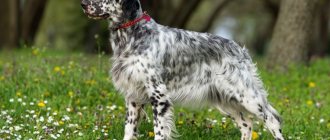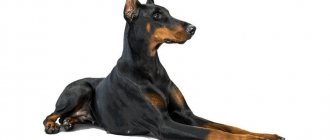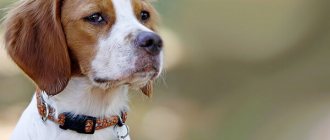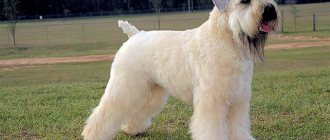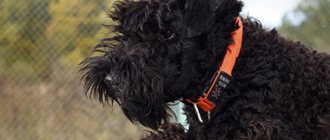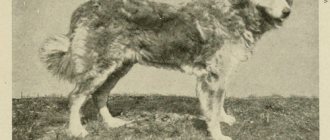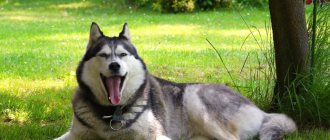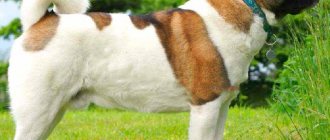Breed characteristics
| Short description | |
| Origin: | England |
| Conditions of detention: | In a city apartment, in a country house with a garden |
| Purpose: | Hunting |
| Color: | Chestnut, brown-red |
| Wool length: | Long, 7 – 8 cm |
| Adult dog size: | The height of females is 55 – 62 cm, the height of males is 58 – 67 cm. The weight of females is 25 – 29 kg, the weight of males is 29 – 32 kg |
| Average life expectancy: | 12 – 15 years |
| Walk: | Needed, 2 times a day |
| Physical exercise needs: | High physical activity needs (regular or daily exercise for more than 3 hours per day) |
| Fédération Cynologique Internationale (FIC) classification: | Group 7 “cops”; Section 2 “British and Irish pointers and setters” |
| Puppy price: | 20 thousand rubles |
Health and Diseases of Irish Setters
The average lifespan of an Irish Setter is 12-15 years. It depends on the owner whether his dog will live a long life. It is the owner who must monitor the health of his pet.
It is necessary to carry out preventive examinations once a year at a veterinary clinic. Deworming, treatment with drugs against skin parasites and routine vaccination are also important.
Irish Setters have been noted to be predisposed to the following diseases:
- Osteosarcoma – distinct lameness and swelling occur at the site of osteosarcoma formation.
- Abdominal bloating - with this problem, it is necessary to take action at lightning speed, since the dog can die within 2-3 hours.
- Otitis media can lead to partial or complete hearing loss.
- Dermatitis is most often allergic.
- Epilepsy – accompanied by convulsions and involuntary bowel movements. The disease cannot be cured, but it can be controlled.
- Hypothyroidism is a lack of thyroid hormones.
- Melanoma is a malignant tumor that develops from pigment cells.
- Idiopathic megaesophagus is an enlargement of the esophagus, a congenital form.
- Entropion can only be eliminated surgically.
- Pyometra is an inflammation of the uterus in bitches, accompanied by purulent discharge.
History of the origin of the species
This dog breed was first mentioned in the 16th century. Irish Setters are distant relatives of breeds such as the Bloodhound and Irish Spaniel . It is known that the first breeders tried not to communicate with each other due to fierce competition, so this breed has many varieties that differ significantly from each other in color and body structure.
The breeders initially set themselves the goal of breeding an animal that would behave easily and naturally among dense bushes, which is why the setter has a hard undercoat and elastic paw pads. Also, dog breeders have worked for a long time to ensure that setters are not afraid of water and loud shots.
History of the breed
The homeland of the red setter is Ireland, where the dog is considered a national treasure. It was developed in the middle of the 19th century. Our hero appeared thanks to the mixing of the blood of an Irish terrier and a water spaniel. It is believed that the ancestors were the English setter, Gordon setter, pointer and Spanish pointers.
The breed was finally formed during the aristocrats' pursuit of fashion and beauty - dogs of red color looked more advantageous at exhibitions (previously, red setters were exhibited in the same ring with other colors).
In 1882, a fan of Irish setters, Cecil Moore, created the first breed club, and 3 years later the breed standard was approved. After some time, two breeding lines appeared: working and exhibition. In 1910, dog handlers in England and Ireland decided to exhibit only dogs with working diplomas.
The modern breed standard characterizes the red setter as a passionate game hunter - the dog enthusiastically helps the hunter track down the bird, and after the shot he brings the carcass to the person.
Distinctive features
This animal is a real aristocrat.
You can recognize an Irish Setter by the following distinctive features::
- Ears – low and deep set, turned forward;
- Tail – widens towards the base, narrows towards the tip, smooth, covered with hair in adult dogs;
- Eyes – brown, tonsil-shaped;
- The body is thin, elongated, the withers are almost invisible;
- Color – red, red-brown;
- The coat is long, with a thick undercoat;
- The nose is black, mobile, the nostrils are large.
You can also recognize this breed by its smooth, leisurely movements. But when the dormant hunting instinct awakens in the animal, the slowness instantly disappears.
Description of the breed
The Irish Setter is amazingly built and well developed physically. The dog's body is proportionate and graceful.
| Appearance | Characteristics |
| Head. | Elongated and quite narrow. The forehead is round, not very high, with a smooth transition to the bridge of the nose. The muzzle is long, proportional to the skull, blunted at the end. The nose is black and large with wide nostrils. Scissor bite. |
| Neck. | Long and muscular. |
| Ears. | Hanging ones of medium length, fitting quite tightly to the head. Located low, closer to the back of the head. |
| Frame. | Moderately long, proportional with a deep chest and slightly arched back and muscular loin. The body is covered with long, thick, shiny hair. |
| Limbs. | Slender, long with well-developed muscles. The paws are small with tightly closed toes. |
| Tail. | Thin, slightly curved, medium length. Continues the line of the body, hangs at rest, and rises slightly above the back when moving. |
| Eyes. | Small oval in size, rich nut or brown color. |
| Color. | Rich chestnut or red. There are dogs with small white spots on the face, chest, and paws. |
Photo of an adult dog
Interesting Facts
- The Irish Setter came to Russia in the 19th century, but was not popular. The reason was the quarrelsome, difficult-to-train nature of the breed. Over time, breeders managed to smooth out these traits and make the dog more obedient.
- The fashion for setters in the USA was set by Franklin Roosevelt, the 32nd President of America had two dogs of this breed at once.
- The special composition of the coat and undercoat allows the setter to feel comfortable on the water, including in swamps.
Photos of puppies
Character
The Irish Setter is an active, energetic, sweet, independent and very good-natured dog.
As a rule, their good nature extends not only to all family members, but also to strangers, and therefore the setter cannot be considered even as a potential guard. But he gets along well with children and other animals.
The Irish get along well with children; they are always patient with the pranks of even the smallest child, and are ready to hang out with older ones all day long. A well-mannered dog values the owner’s favor and will try to do everything not to upset him.
But there are some features in the character of the Irish Setter that are worth knowing about before the dog appears at your home. Being a hunting dog, all setters are very restless by nature and will require a lot of attention and long active walks from the owner. If you do not satisfy your dog's need for physical exercise and emotional release during active games, the animal can become withdrawn, disobedient and even aggressive. Some representatives of the breed, obeying hunting instincts, tend to “chase” cats. A small puppy will most likely get along with a cat without any problems, while making friends between an adult setter and a kitten is not always possible.
Features of character and behavior
This dog is distinguished by the habits of an aristocrat and a high intellectual level . Also, the Irish Setter is very independent, so during training it is very important not to force the animal.
It is useless to force this dog to do anything, so the main task of the trainer is to give the animal a positive incentive.
The Irish Red Setter has long been loved by domestic dog breeders due to its bright color and good-natured, calm character. Unlike other tall hunting dogs, he weighs very little and is not obese.
The main distinguishing features of the breed are its rich brick-red color, long thick hair, and large floppy ears. The animal is easy to train, but the red setter is a poor “guardian”: the animal welcomes strangers and is never the first to show aggression.
- The dog is easy to care for and shedding goes unnoticed. The Red Setter does not have the characteristic “dog” smell. No haircut is required; washing your pet once every 10-12 days . Care for the eyes and ears requires special attention.
- The animal is also susceptible to infectious diseases. Therefore, it is very important to strictly follow the vaccination schedule. Coat care requires great attention, especially during the molting period.
- When feeding a dog, it is very important that the diet be rich in vitamins and minerals , so it is recommended to give preference to commercially produced food for dogs that are highly physically active.
Advantages
Before getting an Irish Setter, you need to weigh the pros and cons, since this dog is not suitable for everyone. Among the undoubted advantages of the breed, the following should be noted:
- Easy to care for;
- Activity and ebullient energy;
- High level of intelligence. Setters are easy to train and easily learn basic commands;
- Spectacular appearance. This is especially important for those owners who dream of raising a champion dog, a winner of exhibitions;
- Peaceful, calm disposition, complete absence of aggression.
If the animal is regularly walked and fed well, the dog will always be calm and friendly. Improper maintenance and poor care can provoke aggression.
Flaws
Despite the obvious advantages, this breed also has serious disadvantages. The following can be distinguished:
- Due to the peculiarities of the anatomical structure of the ears, people often suffer from otitis media and suffer from ear mites;
- Sensitive to any changes in the usual diet, susceptible to stomach and intestinal disorders. Setters should never be overfed, otherwise the animal may die from volvulus;
- During sexual activity, as well as during hunting, sometimes it becomes uncontrollable;
- The freedom-loving and wayward setter does not understand the “come to me” command well;
- Pedigree puppies are quite expensive.
It should also be noted that the animal does not feel well if it is not walked and exercised enough. There is no way to lock a setter “within four walls .
Pros and cons of the breed
Red setters have both advantages and certain disadvantages.
| Advantages | Flaws |
| Friendly character | Shedding is not heavy, but constant |
| Innate intelligence | Need for long walks with intense physical activity |
| Easy to Feed | Serious difficulties in keeping the dog on a leash if it sees a bird, mouse or large insect while walking |
| Almost no barking | Difficulties in adding new pets to a setter if he is already an adult Risk of giving birth to puppies with vision problems and blind due to a recessive gene |
| Beautiful appearance | Difficulties when adding new pets to a setter if he is already an adult |
Care and maintenance
- its fur every day , removing the old undercoat so that the skin can breathe freely. Particular attention should be paid to these activities during the molting period. There is no need to wash your pet partly so as not to wash off the protective lubricant on the skin.
- If it is windy or cold outside , the dog will benefit from a suit and special shoes made exactly to size. But walking in shoes is often not recommended; it is harmful to the claws.
- The fur on the ears and belly is trimmed to prevent it from matting.
- your ears every week . Small black dots on the inner surface of the ears indicate infection with ear mites, in which case you should consult a specialist. If swelling, edema, or inflammation , you should definitely show the animal to a veterinarian, since setters often suffer from otitis media.
- When washing your pet, you need to be careful not to let water get into your pet's ears.
- Teeth are brushed every 10-14 days with a paste for dogs; it can be bought at veterinary pharmacies.
- Caring for your eyes is not so troublesome - it’s enough to examine them and wipe them with strong tea leaves at the first signs of conjunctivitis. Sometimes setters develop a white coating on their eyelids, and the dog cannot open his eyes. In this case, you should immediately consult a doctor.
- claws wear down on their own during walks. But if you rarely walk your dog, they grow back quickly. In this case, they are trimmed with a special nail clipper. You can also purchase a scratching post for your pet.
Nutrition
Hunters usually feed their pets dry food because it is convenient and easy. But you can add good quality natural products to your animal’s diet. For a puppy, the best food is milk and cottage cheese. Gradually, meat is introduced into the diet. Puppies are fed 5-6 times a day, adult dogs 3-4 times. During teething, small cartilages are added to the menu.
The diet of an adult dog, with natural feeding, should include:
- Porridge;
- Low-fat sea fish;
- Liver and other offal;
- Cartilages;
- Chicken and turkey;
- Boiled vegetables.
Your pet should always have a bowl of fresh water. It should be comfortable so that your ears don’t get caught in it while drinking. As the dog grows, the food and water bowls change.
Health
The Irish Setter is naturally endowed with good health and stamina. However, these animals often have congenital malformations of varying severity, and bitches have difficult births.
Therefore, when choosing a puppy, it is necessary to clarify what diseases its parents suffered from.
These hunting dogs often suffer from parasites - fleas, ticks, lice eaters. With an incorrect diet, helminthic diseases, various allergic reactions, and individual intolerance to certain foods are possible.
An animal that participates in exhibitions should be regularly observed by a veterinarian before events. If there is the slightest health problem, the exhibition must be canceled so that it does not become a serious stress for the pet.
Vaccinations
Since the setter is a hunting dog, it is impossible to do without an annual rabies vaccination. Also, your pet must be vaccinated against distemper, viral hepatitis and leptospirosis. All information about vaccinations is entered into the dog’s veterinary passport, which the owner will need when transporting the animal, when participating in exhibitions and agility.
Setters tolerate vaccination well, but after vaccination local allergic reactions (for example, redness at the injection site) may occur . If after vaccination the dog becomes lethargic, drowsy, has an upset stomach or has a fever, you should immediately consult a doctor.
The first vaccination is given at 2 months, then at 6–7 months, at one and a half years, and after that the vaccination should be repeated annually.
Diseases
This breed often suffers from skin diseases, the most common of which is interdigital dermatitis. Due to the anatomical structure of the eyes, viral conjunctivitis often occurs. Setters also suffer from diseases such as:
- Retinal dystrophy and atrophy;
- Volvulus;
- Stomach and intestinal disorders;
- Cancer;
- Congenital underdevelopment of the hip joints.
Setters often develop a yellowish or gray coating on their teeth that is practically permanent. This is tartar; to prevent it, your pet needs to brush its teeth periodically. To remove tartar, you should contact your veterinarian.
Walk
The Setter is a dog for those who are lonely and can give their pet a lot of attention, including daily walks.
- This pet is not suitable for a calm, leisurely walk accompanied by a pensioner or teenager. The ideal walk for a Setter is a hunting trip, cross-country running, running and jumping in a forest clearing. During walks, you should avoid contact with other animals, especially if the setter does not understand the “come to me” command well.
- If the dog sees something that looks like game (for example, a cat), his behavior can become unpredictable in an instant. Therefore, it is best to walk in a special dog area. After a walk, the dog’s paws are wiped and the fur is examined for parasites.
Grooming
- The coat should be brushed regularly with a stiff massage brush. This is not only an important hygienic measure, but also the prevention of serious skin diseases. If long hair is not taken care of, it will become tangled.
- The resulting tangles are carefully cut off with sharp scissors, being careful not to touch the skin . The wool is scratched from bottom to top, from paws to neck, in the direction of its growth. These activities should be carried out when the dog is in a calm, peaceful mood, for example, after feeding. You can also brush a sleeping pet.
- When washing, you must use shampoo for long-haired dogs.
- You need to brush your dog daily. Dogs shed twice a year. During the molting period, it is better to comb the animal twice a day, then this moment will pass almost unnoticed.
- Wash your dog no more than once a week, maybe once every 2 weeks or even once a month. If the animal gets very dirty after a walk, just wipe it with a damp towel, paying special attention to the places between the toes (the most dirt accumulates there).
Training and coaching
The setter loves training. This dog is easy to train, but it requires a soft, delicate approach - the dog has a good memory, and he will remember rudeness or cruelty for a long time. When training, use positive reinforcement .
To make a dog become a hunter, carry out training. They start it when the puppy is 6-8 months old. At work, the Irish Setter searches for game, moving in a shuttle ahead of the hunter and using its upper senses, smelling through the air. Therefore, training begins with the person teaching the dog to move correctly.
The first stage of training takes place in the meadows in the presence of a steady wind. A young dog sets off into the wind after the command “search” and the direction of search. After the command, the person must run in the indicated direction, and the dog gets ahead of him and moves on. After a short whistle, change direction and continue practicing. At first, you can control the dog with a long leash - a cord.
Next, move on to practicing the stance: hang pieces of cheese on the grass just above the level of the dog’s head. Send your dog on a search and point to the “cheesy” places. Then hold the dog in front of the cheese and after a while, command “forward” so that the dog will come and eat the treat. Praise your dog for every correct posture.
The last stage is training the dog to shoot and the command to “lie down” after picking up the game. Do not train a young dog in calm weather.
Mating
Bitches and dogs are bred only after they are two years old. Before this event, the dog is walked, but not fed. The pets are introduced on the street and then transported to the male’s territory. Typically, dogs that have reached puberty understand perfectly well what is required of them, and the owner’s intervention is not required. 1 - 2 days after the meeting of the male and female, a control mating should be carried out.
A girl's estrus lasts 21 days; it is best to breed at the beginning or in the middle of estrus. The best age for mating is from 2.5 to 5 years. You should knit once a year, not more often.
Attitude towards children and pets
Irish Setters are family friendly. However, you need to understand that these are large and active dogs. They can knock a small child off his feet. Always supervise any interactions between dogs and small children. Teach your child never to approach any dog while it is sleeping or eating, or to try to take food from it. No dog should be left unattended with a child.
Irish Setters also get along well with other dogs in the house, as well as cats, especially if they are raised together, but they may view poultry as prey since that is what they are raised on.
Key points in training
Despite the high level of intelligence, the animal can become uncontrollable when the hunting instinct awakens.
When raising and training a pet, you need to be persistent and consistent. Dogs master hunting commands best - for example, “Fetch!”). The worst of all are the commands “Come to me!” and “Nearby!”
You should also pay special attention to the “No!” , the dog must carry it out unquestioningly. If the Setter does not understand prohibition commands well, he will not make a good hunter's assistant. By the age of 10 months, the animal must learn basic commands, know its place and name.
Read about how to properly train a dog in the article: “Training a puppy: effective methods from dog handlers, learning commands at home.”
Dogs older than one year can handle more difficult tasks . It should be borne in mind that sometimes among Setters there are specimens that are in puppyhood up to 2 years . They require an individual approach, preferably with a professional dog handler. But in this case, you should not rush to start classes.
Breed Features
The Irish Setter is famous for its mischievous, cheerful character and good disposition. These dogs are very people-oriented, but at the same time they are one of the most independent breeds. If the owner does not initially show leadership, the dog will stop listening and will behave too independently.
Such self-sufficiency of the breed also negatively affects training. Independent and stubborn in his ways, the setter will not follow commands if he decides not to do them for any reason. Despite such stubbornness, these dogs are quite smart and capable of learning; the owner will just have to try to find an approach to their pet.
It is important to note the special friendliness of these dogs. Despite their hunting temperament, they get along well with different animals and can even coexist with other dogs. The setter must warn of prey, but not attack it, so there is practically no aggression in their genes.
In families with children, owners must carefully monitor the communication process between the child and the dog, because this friendly dog will patiently endure rough and unpleasant games.
How to choose a puppy
- It is best to choose a puppy in a nursery. When choosing, you should pay attention to the condition of the baby’s eyes and ears. If a puppy notices a stranger or a toy from afar and shows interest, it means he has good eyesight.
- A lack of interest in the outside world or discharge from the eyes may indicate congenital vision problems, which are common in this breed.
The Irish Setter is an ideal option for active and sporty owners. But this animal is not suitable for elderly people and families with small children. With proper training and upbringing, a dog can become an excellent hunting assistant or companion during outdoor activities.
Prices
For the Irish Setter breed, the price depends on a number of factors: the prestige of the nursery, its distance from the central region, the class of the animal and the status of its parents.
Depending on the kennel, an Irish Setter puppy in Moscow and St. Petersburg can be bought for 20-60 thousand rubles:
- Representatives of the pet class, which will make excellent pets, cost from 20 to 40 thousand rubles. Puppies of this class differ from the breed standard and do not participate in breeding, but will become wonderful companions and true friends.
- Breeding class puppies cost from 25 to 50 thousand rubles.
- Show-class puppies that fully comply with the standard and future champions of exhibitions can be purchased for 30-60 thousand rubles.
Offers on sites like Avito or bird markets should not be taken seriously. You can use them to purchase a puppy without documents, without knowing anything about the parents, hereditary defects or character problems.
Photos from Irish Setter owners
[webnavoz_instagram json=”{'link':'https:\/\/www.instagram.com\/p\/BrVOV8mFPia\/','author':'ksenia_i_lisenok','link_img':'https:\/\ /instagram.fhen1-1.fna.fbcdn.net\/vp\/29fd3b1aab3f3d3242713e35a89795c6\/5D4248BF\/t51.2885-15\/e35\/46466436_274915973383216_87439611386 65881600_n.jpg?_nc_ht=instagram.fhen1-1.fna.fbcdn.net '},{'link':'https:\/\/www.instagram.com\/p\/BoesjvUns0C\/','author':'akita_setter_lekdeiri','link_img':'https:\/\/instagram .fhen1-1.fna.fbcdn.net\/vp\/60815d9b1ca501e29f3ae7b1d2170f84\/5D44A235\/t51.2885-15\/e35\/41611648_340659096501207_363528353337804 0245_n.jpg?_nc_ht=instagram.fhen1-1.fna.fbcdn.net'} ,{'link':'https:\/\/www.instagram.com\/p\/BvPAJ-Jlh_x\/','author':'ksenia_i_lisenok','link_img':'https:\/\/instagram .fhen1-1.fna.fbcdn.net\/vp\/0d39f81987c70cf1b8c735432a4f173e\/5D3585C4\/t51.2885-15\/e35\/53109607_1219713691527121_132272122111 4802333_n.jpg?_nc_ht=instagram.fhen1-1.fna.fbcdn.net'} ,{'link':'https:\/\/www.instagram.com\/p\/Bp46sJNAMdE\/','author':'katerinapolkovnikova','link_img':'https:\/\/instagram.fhen1 -1.fna.fbcdn.net\/vp\/0a016c7dc61ff789fd3a47e72bacab3e\/5D467DC3\/t51.2885-15\/e35\/43249423_2086044805039046_3219062049728364544_n .jpg?_nc_ht=instagram.fhen1-1.fna.fbcdn.net'},{ 'link':'https:\/\/www.instagram.com\/p\/BwGyB6mHLs9\/','author':'batalov_photo','link_img':'https:\/\/instagram.fhen1-1 .fna.fbcdn.net\/vp\/2188f2df1c8377449b64a9f45ae2e737\/5D460689\/t51.2885-15\/e35\/55763151_306514436690216_9156237189378072585_ n.jpg?_nc_ht=instagram.fhen1-1.fna.fbcdn.net'},{'link ':'https:\/\/www.instagram.com\/p\/BwEavJiA9LD\/','author':'miron_irishsetter','link_img':'https:\/\/instagram.fhen1-1.fna .fbcdn.net\/vp\/a7f6c25974058090cf3a8c5bfec27602\/5D332076\/t51.2885-15\/e35\/55906309_127582658334153_8412414587915067939_n.j pg?_nc_ht=instagram.fhen1-1.fna.fbcdn.net'},{'link': 'https:\/\/www.instagram.com\/p\/BwBxQUxgjsS\/','author':'miron_irishsetter','link_img':'https:\/\/instagram.fhen1-1.fna.fbcdn .net\/vp\/7bd312e77290debc5d6d0703f8413804\/5D400A84\/t51.2885-15\/e35\/56593835_3156825961010329_1036183141387991870_n.jpg?_nc_ ht=instagram.fhen1-1.fna.fbcdn.net'},{'link':'https :\/\/www.instagram.com\/p\/BwBg7z7Ju5O\/','author':'akita_setter_lekdeiri','link_img':'https:\/\/instagram.fhen1-1.fna.fbcdn.net \/vp\/59a18f58afd4a46448fa75464a9924c4\/5D345BD2\/t51.2885-15\/e35\/55931153_2279519975626059_3727294142466447312_n.jpg?_nc_ht= instagram.fhen1-1.fna.fbcdn.net'},{'link':'https:\ /\/www.instagram.com\/p\/Bv_QPoWgqnG\/','author':'miron_irishsetter','link_img':'https:\/\/instagram.fhen1-1.fna.fbcdn.net\/ vp\/7f1206919bf2d0f0db160155bc670a68\/5D3B295B\/t51.2885-15\/e35\/54447130_2305173966404711_3055553590054735418_n.jpg?_nc_ht= instagram.fhen1-1.fna.fbcdn.net'},{'link':'https:\/\ /www.instagram.com\/p\/Bv8hD0SgXFx\/','author':'shallwedancekennel','link_img':'https:\/\/instagram.fhen1-1.fna.fbcdn.net\/vp\ /ab9d99de39eb99bb8fed88bdf28d045e\/5D33F9DB\/t51.2885-15\/e35\/54732261_2260866954162877_7446272845757787785_n.jpg?_nc_ht=instagram.fhen1-1 .fna.fbcdn.net'}”]
Diseases and life expectancy
The Irish are considered a fairly healthy breed, without serious hereditary diseases. The setter's weaknesses include:
- tendency to otitis media;
- problems with the gastrointestinal tract, up to volvulus;
- increased cholesterol levels;
- stones in the kidneys;
- hip dysplasia.
Proper care and lifestyle can reduce the risk of these diseases to a minimum. If you follow the recommendations for maintenance and nutrition, and timely visit the veterinarian, the life expectancy of a representative of this breed reaches 15 years.
Training
Irish Setters are very intelligent and highly trainable, but only if the owner can find the right approach. Most dogs of this breed are independent, do not accept rough treatment and do not like monotony. They require equality, gentleness and a mandatory system of rewards from the owner in the form of treats or thunderous praise. Setters also need regular exercise and repetition. It is very important from an early age to accustom the puppy to the rules of behavior at home and on the street, as well as hygiene procedures.
Important! The Irish Setter requires a mandatory training course, the result of which should be complete obedience to the owner.
This will not only make it easier to learn special commands, but will also help avoid problems during walks. Setters are prone to sudden escapes. During a walk, a dog can pick up a scent and forget about everything in the world. Due to its persistent nature and some ardor, training with an Irish Setter is a little more difficult. Classes begin at approximately 6-8 months of age, and the dog is given full exercise only after 9 months.
Irish setters especially like fetch, games with a ball, rings and Frisbee, as well as “hide and seek” with various objects and tasks to find game. With incredible pleasure, setters will also catch up with the mechanical crawler in special areas for training hunting dogs. Such entertainment will be an excellent release of pent-up energy, even for dogs whose owners never plan to use them in hunting.
Training hunting dogs involves the following stages:
- General training designed to make the setter primarily obedient and controllable.
- Formation of a certain type of hunting behavior, taking into account the type of hunting in which the dog will be used.
Setters are indispensable when hunting game birds. Dogs are excellent at finding a bird hidden in the grass or thickets, lifting it “on the wing” under the hunter’s gun, and then finding and serving game. Of course, the process of learning all these skills requires persistence and patience from the owner.
